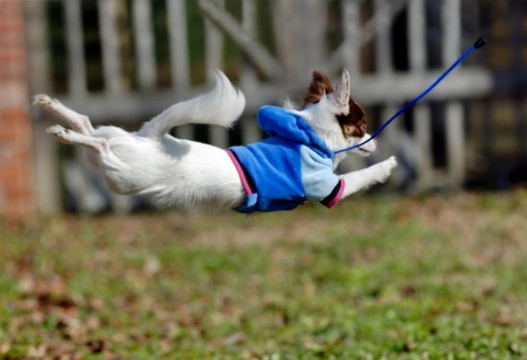
Dancing with your dog - Heelwork to music
If you're a fan of Crufts or even Britain's Got Talent, then you may have heard of heelwork to music. Heelwork to music is a sport performed with a dog and handler, which involves a combination of obedience training, dance, choreography and a flair for performance.The sport evolved from the discipline of musical canine freestyle in the 1990's, and is now recognised by The Kennel Club as a non breed specific discipline, with an invitational Crufts competition in heelwork to music held in 2005, and the first open competition held in 2006. Although a relatively new discipline in competition, heelwork to music is very watchable, and is becoming a popular sport for both competitors and spectators alike within the UK and further afield.
What is heelwork to music?
Heelwork to music has its basis in obedience training, albeit taken to a whole new level with an incredibly high standard of discipline and intelligence required from the dog. A routine is devised by the dog's handler, set to music, and involves the dog displaying its skills and obedience as well as the handler's communication with their dog as part of a short choreographed routine. Understandably, devising and learning a whole routine, performing it effectively and teaching your dog a wide enough range of skills and tricks to make the performance visually appealing, requires a high degree of intelligence and willingness to please from the dog, and concentration and commitment from the handler. A routine can take many weeks or months to perfect and execute reliably time after time, even for dogs and handlers at the highest levels of competition.There are two styles of heelwork to music and associated competition classes- freestyle, where the entire routine and its component parts are devised by the handler with no restrictions or compulsory elements, and then classes where two thirds of the routine is comprised of heelwork with set elements with the final third choreographed freestyle as the handler wishes. Heelworks to music routines generally involve the use of themed outfits for the handler and possibly the dog, and can include the use of props and accessories. Perfect for people who like to utilise their creative talents!
What makes a successful heelwork to music routine?
The choice and style of music are important to the overall effect of the routine, how visually appealing it is, and how it captures the interest of the audience and the judges. How smoothly you and your dog move through the routine, how well your dog follows your directions and how well you both keep time with the tempo and tone of the music are all factors to consider. Your routine should be designed to show off your dog's skills and obedience, and well executed displays performed by an effective handler and well trained dog with a wide range of skills are visually very impressive, and often reach their conclusion to the sound of tumultuous applause and cheering. The routine should be fresh and new, involving a wide range of different movements and skills, and avoid unnecessary repetition of any particular elements.
What kinds of dogs and people can do heelwork to music?
Any dog can try their paw at heelwork to music- the discipline is not reserved for pedigree dogs only. A wide range of breeds and types of dogs large and small take to heelwork to music, and there is no one type of dog that is particularly successful over any other.For a dog to succeed at heelwork to music, they will need to have a high level of general intelligence, be receptive to training and able to retain knowledge of a wide range of skills and commands, so a good level of basic training, obedience and recall are vital to begin with. Your dog will also need to be fairly agile and physically fit, and heelwork to music certainly helps to develop agility and fitness in both the dog and their handler- and maintain it.You do not have to be particularly musically inclined or have any previous dance experience to get started- you will learn along with your dog. Heelwork to music can be a fairly energetic exercise for the handler as well as the dog, and if you're looking for a fun way to get fit with your dog then heelwork to music is definitely a good way to go about it.Dogs can begin competing in Kennel Club affiliated heelwork to music events and competitions from one year old, and there are no age restrictions for handlers. In order to compete in any Kennel Club heelwork to music competitions or qualifying heats, your dog must first be registered either on the Kennel Club breed register for pedigree dogs which also compete in breed classes, or the Kennel Club Activity Register for non pedigree dogs.
How do I get started?
You don't need any previous experience to start out with heelwork to music- just a good relationship with your dog and a belief that heelwork to music would be fun and beneficial to you and your pet. You won't know if you and your dog have a flair for it until you try, and it can be hard to know where to start unless you know another dog and owner who are already involved in the sport. There are various clubs and classes for heelwork to music competitors and enthusiasts all over the UK, and all of them actively welcome new members and interested enthusiasts who are keen to have a go. As with any organised dog sport or training classes involving dogs, most clubs will require that your dog is fully vaccinated against the main communicable canine diseases and conditions before you can go along.
Further information
If you're keen to find out more and maybe have a go at heelwork to music with your dog, check out the following links.Paws 'n' Music AssociationK9 Freestyle Dancing Dogs



